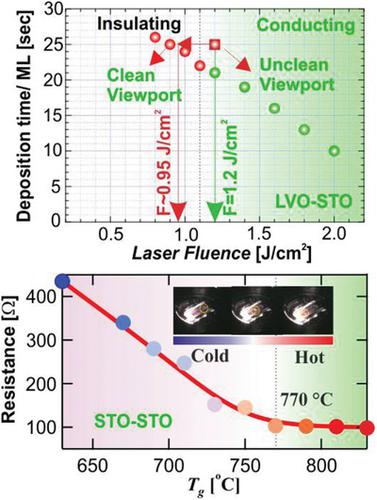当前位置:
X-MOL 学术
›
Cryst. Res. Technol.
›
论文详情
Our official English website, www.x-mol.net, welcomes your
feedback! (Note: you will need to create a separate account there.)
A Case Study to Address: “Is Your Pulsed Laser Deposition Chamber Clean?”
Crystal Research and Technology ( IF 1.5 ) Pub Date : 2021-05-25 , DOI: 10.1002/crat.202000186 Manish Dumen 1 , Ripudaman Kaur 1 , Saveena Goyal 1 , Ruchi Tomar 1 , Neha Wadehra 1 , Suvankar Chakraverty 1
Crystal Research and Technology ( IF 1.5 ) Pub Date : 2021-05-25 , DOI: 10.1002/crat.202000186 Manish Dumen 1 , Ripudaman Kaur 1 , Saveena Goyal 1 , Ruchi Tomar 1 , Neha Wadehra 1 , Suvankar Chakraverty 1
Affiliation

|
Pulsed laser deposition (PLD) is one of the important techniques for the growth of oxide thin films, interfaces, and superlattices. It can also be utilized to implement diverse combinatorial approaches. Thin film growth using PLD hinges on various parameters that decide the composition, structure, quality, and finally the physical properties of the films, interfaces, and superlattices. In this paper it is demonstrated how the growth conditions inside the chamber during the growth can be judged from outside by combining in situ and ex situ techniques. An example of the growth of LaVO3-SrTiO3 interface is given to elucidate the effect of repetitive growth on the chamber condition and hence on the reproducibility of the physical properties of the samples. The experiments suggest noticeable change in transport properties with successive deposition processes.
中文翻译:

要解决的案例研究:“您的脉冲激光沉积室干净吗?”
脉冲激光沉积 (PLD) 是氧化物薄膜、界面和超晶格生长的重要技术之一。它还可以用于实现多种组合方法。使用 PLD 的薄膜生长取决于各种参数,这些参数决定了薄膜、界面和超晶格的成分、结构、质量以及最终的物理特性。本文展示了如何通过结合原位和非原位技术从外部判断生长过程中腔室内的生长条件。LaVO 3 -SrTiO 3的生长示例给出了界面以阐明重复生长对腔室条件的影响,从而对样品物理特性的再现性产生影响。实验表明,随着连续沉积过程,传输特性发生了显着变化。
更新日期:2021-05-25
中文翻译:

要解决的案例研究:“您的脉冲激光沉积室干净吗?”
脉冲激光沉积 (PLD) 是氧化物薄膜、界面和超晶格生长的重要技术之一。它还可以用于实现多种组合方法。使用 PLD 的薄膜生长取决于各种参数,这些参数决定了薄膜、界面和超晶格的成分、结构、质量以及最终的物理特性。本文展示了如何通过结合原位和非原位技术从外部判断生长过程中腔室内的生长条件。LaVO 3 -SrTiO 3的生长示例给出了界面以阐明重复生长对腔室条件的影响,从而对样品物理特性的再现性产生影响。实验表明,随着连续沉积过程,传输特性发生了显着变化。











































 京公网安备 11010802027423号
京公网安备 11010802027423号